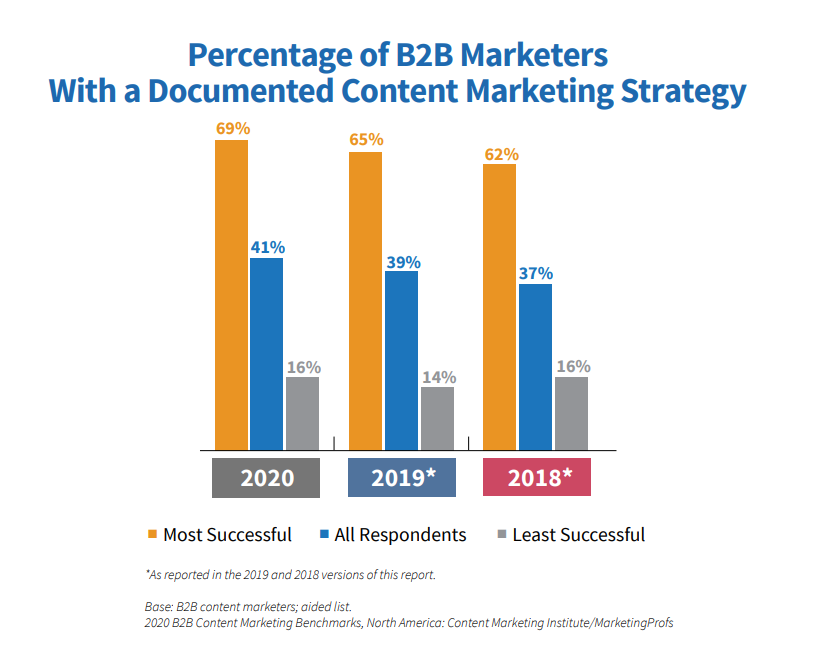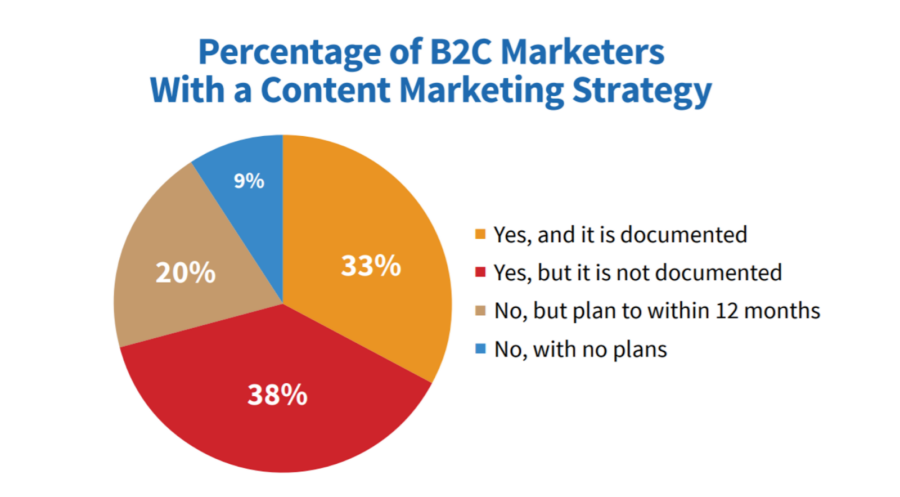A content marketing plan has a crucial role to play in the success of your business. If you’re doing content marketing without a strategy in place, the chances are high that you may not succeed at it. Also, it’s not enough to just have a content plan in place. You also need to document it well.
And facts point towards that too.
About 69% of the most successful B2B businesses have a well-documented content strategy. On the other hand, only about 16% of the least successful businesses have one.

Image via Content Marketing Institute
And guess what?
It’s not just the B2B businesses that see some success when they leverage content marketing with a plan in place. Even B2C businesses echo the same. The vast majority of them (71%) have a content marketing strategy in place and 33% of them have also documented it.
Image via Content Marketing Institute
So, now that it’s clear that you need a content marketing plan for the success of your business, let’s try to understand how you can go about creating one.
Content Marketing Plan: How Can You Create One?
Here are the various steps that you can take to start creating your content marketing plan from scratch.
1. Set Your Goals and KPIs
When you set out to create a content marketing plan for your business, you need to start by identifying and noting down your goals. The idea here is to find out what it is you want to achieve from your content marketing efforts.
Some of the goals you can set are:
- Grow your reach
- Generate more sales
- Find more leads
- Boost your revenue
But why should you set these goals in the first place?
The idea behind setting goals for your content marketing plan is to ensure that you won’t be shooting an arrow in the dark. Instead, all of your efforts will be made such that they’ll be targeted towards that goal.
You must also create a sales funnel for your brand using templates so that you can figure out what needs to be done at each stage.
What’s more?
Based on the goals, you’ll also be able to determine the various key performance indicators (KPIs) that you can use to measure your progress. Some KPIs would be your website traffic, the number of leads, revenue generated, etc.
2. Find Your Audience
Setting goals isn’t enough. To be able to market your brand, you must also know who you’re marketing to. That’s why it’s crucial to understand and define your target audience.
For this, you need to conduct market research. Some of the ways of doing this are:
- Competitor analysis
- Customer interviews
- Customer surveys
- Focus groups
Based on your market research, you should define your target audience by describing their demographic, geographic, and psychographic factors.
Also, you should segment this audience further and create buyer personas that can help you target segments in your audience even better.
3. Analyze Your Current Position
Once you’ve got your goals and audience defined, you need to get a clear understanding of where you currently stand in comparison to your goals. Doing so is important as it’ll help you chart out the path that you need to take to accomplish them.
But that’s not the only position you need to see.
It’s also necessary to consider where you stand in comparison to your competitors. You can do so by leveraging competitor analysis tools that can show you how your content fares compared to theirs.
This sort of audit of content is even recommended if you’re starting out from scratch. It’ll give you a clearer picture of what needs to be done to go from there to your goals.
4. Create a Content Calendar
The next thing that your content marketing plan needs to have is a content calendar that will outline what will be published when and where. Content calendars are necessary for the smooth planning and publishing of your content.
And what’s needed for them?
Based on your target audience, you need to decide what content you need to produce. Also, audience research will help you find the right platforms for publishing your content. Both of these factors will help you plan your content calendar.
But why are content calendars necessary?
This can help ensure that everything is published at the right time so that there’s consistency in your publishing. Without consistency, you might end up in a situation where your audience might either be overwhelmed with your content or may think your brand is inactive.
Be it blog posts, social media content, or even podcasts, a content calendar will help you maintain consistency across all channels and that’s why you should include it in your content marketing plan.
5. Create and Distribute Content
The next step to build your content marketing plan is to outline the steps that will go into the creation and distribution of the content.
These steps are critical as the success of your content marketing plan depends on how effective your content is and how well you distribute it.
Outlining the steps for creating and distributing content will ensure that all the operations are done such that they drive results. You also need to mention the different tools for content writing and distribution that you would be using.
What’s more?
You can amp up the reach of your content by leveraging influencers as well. That’s why it helps to include influencer marketing in your content marketing plan too.
These influencers typically have a large and engaged audience. As a result, when they share your content, you’ll be able to reach a wider audience who might even check your brand out.
However, for this to happen, you need to be able to find the right influencers for your brand.
6. Measuring Results
Finally, the last step in creating your content marketing plan is that of measuring the results of your marketing efforts.
In this step, you need to highlight the various methods that you will implement to track your KPIs and figure out where you stand. You also need to elaborate on the various content analytics tools that you will use.
Final Thoughts
To ensure that you get the most out of your content marketing efforts, it’s essential to outline a content marketing plan. For this, you should start by setting your goals and identifying the relevant KPIs. You must also research your target audience and define the various buyer personas.
It’s important to see where you currently stand and accordingly create a content calendar to chart out your path to accomplish your goals.
What’s more?
You must also outline all the steps that need to be taken to create and publish your content the right way. Finally, elaborate on the various tools and processes you’ll follow to analyze your progress.
Do you have any questions about the steps involved in creating a content marketing plan? Ask them in the comments.
